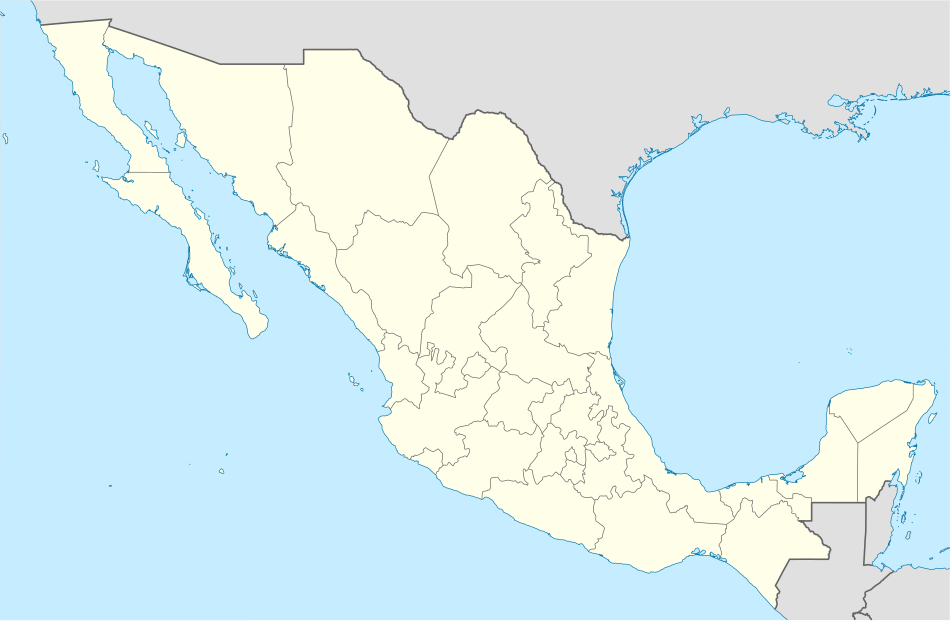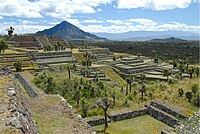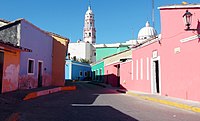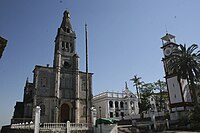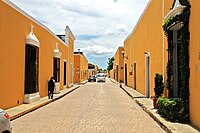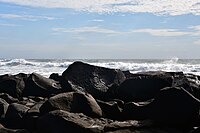List of World Heritage Sites in Mexico
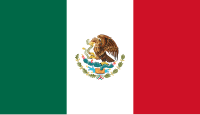
The United Nations Educational, Scientific and Cultural Organization (UNESCO) World Heritage Sites are places of importance to cultural or natural heritage as described in the UNESCO World Heritage Convention, established in 1972.[1] Mexico accepted the convention on 23 February 1984, making its historical sites eligible for inclusion on the list. As of 2018, there are thirty-five World Heritage Sites in Mexico, including twenty-seven cultural sites, six natural sites and two mixed sites.[2] The country ranks first in the Americas and seventh worldwide by number of Heritage sites.
Mexico's first six sites, Sian Ka'an, Pre-Hispanic City and National Park of Palenque, Historic Centre of Mexico City and Xochimilco, Pre-Hispanic City of Teotihuacan, Historic Centre of Oaxaca and Archaeological site of Monte Albán, and Historic Centre of Puebla, were inscribed on the list at the 11th Session of the World Heritage Committee, held at UNESCO headquarters in Paris, France in 1987.[3]
In addition to its inscribed sites, Mexico also maintains twenty-one properties on its tentative list, considered for future nomination.[4]
There are also 9 traditions and celebrations considered Intangible Cultural Heritage of Mexico: Indigenous festivals dedicated to the dead, the ceremony of the Flying Dancers, the pilgrimage to Peña de Bernal, the traditional January party of Chiapa de Corzo, the traditional song of the Purépechas, traditional Mexican cuisine, Mariachi music, the charrería and the pilgrimage to Zapopan.[5]
Location of sites[edit]
Numbered sites: 1. Downtown Mexico City and Xochimilco; 2. Central campus of the University City of UNAM; 3. Monasteries on the slopes of Popocatépetl; 4. Luis Barragan House and Studio; 5. Aqueduct of Padre Tembleque; 6. San Miguel de Allende
Legend: ![]() World Cultural Heritage Site;
World Cultural Heritage Site; ![]() World Natural Heritage Site;
World Natural Heritage Site; ![]() World Cultural and Natural Heritage Site (Mixed);
World Cultural and Natural Heritage Site (Mixed); ![]() Silver Road (cultural).
Silver Road (cultural).
World Heritage Sites[edit]
- Site; named after the World Heritage Committee's official designation[6]
- Location; at city, regional, or provincial level and geocoordinates
- Criteria; as defined by the World Heritage Committee[7]
- Area; in hectares and acres. If available, the size of the buffer zone has been noted as well. A lack of value implies that no data has been published by UNESCO
- Year; during which the site was inscribed to the World Heritage List
- Description; brief information about the site, including reasons for qualifying as an endangered site, if applicable
| Site | Image | Location | Criteria | Area ha (acre) |
Year | Description |
|---|---|---|---|---|---|---|
| Historic Center of Mexico City and Xochimilco |   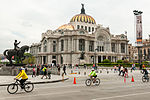 |
Mexico City 19°25′6″N 99°7′58″W / 19.41833°N 99.13278°W |
Cultural: (ii)(iii)(iv)(v) |
— | 1987 | Founded in the 1300s under the name Tenochtitlan, the Aztec capital, and destroyed and rebuilt as Mexico City by the Spanish in 1521, it is now one of the world's largest and most densely populated cities. It had five Aztec temples, the ruins of which have been identified, a cathedral (the largest on the continent) and some fine 19th- and 20th-century public buildings such as the Palacio de las Bellas Artes. Xochimilco lies 28 km south of Mexico City. With its network of canals and artificial islands, it testifies to the efforts of the Aztec people to build a habitat in the midst of a lake. Its characteristic urban and rural structures, built since the 16th century and during the colonial period; have been preserved in an exceptional manner[8] |
| Historic Centre of Oaxaca and Archaeological site of Monte Albán | 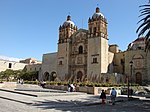 
|
Oaxaca 17°3′43″N 96°43′18″W / 17.06194°N 96.72167°W |
Cultural: (i)(ii)(iii)(iv) |
375 (930) | 1987 | Inhabited over a period of 1,500 years by a succession of peoples – Olmecs, Zapotecs and Mixtecs – the terraces, dams, canals, pyramids and artificial mounds of Monte Albán were literally carved out of the mountain and are the symbols of a sacred topography. The nearby city of Oaxaca, which is built on a grid pattern, is a good example of Spanish colonial town planning. The solidity and volume of the city's buildings show that they were adapted to the earthquake-prone region in which these architectural gems were constructed.[9] |
| Historic Centre of Puebla | 
|
Puebla 19°2′50″N 98°12′13″W / 19.04722°N 98.20361°W |
Cultural: (ii)(iv) |
690 (1,700) | 1987 | Puebla, which was founded ex nihilo in 1531, is situated about 100 km east of Mexico City, at the foot of the Popocatepetl volcano. It has preserved its great religious structures such as the 16th–17th-century cathedral and fine buildings like the old archbishop's palace, as well as a host of houses with walls covered in tiles (azulejos). The new aesthetic concepts resulting from the fusion of European and American styles were adopted locally and are peculiar to the Baroque district of Puebla.[10] |
| Pre-Hispanic City and National Park of Palenque | 
|
Chiapas 17°29′0″N 92°3′0″W / 17.48333°N 92.05000°W |
Cultural: (i)(ii)(iii)(iv) |
1,772 (4,380) | 1987 | A prime example of a Mayan sanctuary of the classical period, Palenque was at its height between AD 500 and 700, when its influence extended throughout the basin of the Usumacinta River. The elegance and craftsmanship of the buildings, as well as the lightness of the sculpted reliefs with their Mayan mythological themes, attest to the creative genius of this civilization.[11] |
| Pre-Hispanic City of Teotihuacán | 
|
State of Mexico 19°41′30″N 98°50′30″W / 19.69167°N 98.84167°W |
Cultural: (i)(ii)(iii)(iv) |
3,381.71 (8,356.4) | 1987 | The holy city of Teotihuacan ('the place where the gods were created') is situated some 50 km north-east of Mexico City. Built between the 1st and 7th centuries A.D., it is characterized by the vast size of its monuments – in particular, the Temple of Quetzalcoatl and the Pyramids of the Sun and the Moon, laid out on geometric and symbolic principles. As one of the most powerful cultural centres in Mesoamerica, Teotihuacan extended its cultural and artistic influence throughout the region, and even beyond.[12] |
| Sian Ka'an | 
|
Quintana Roo 19°23′0″N 87°47′30″W / 19.38333°N 87.79167°W |
Natural: (vii)(x) |
528,000 (1,300,000) | 1987 | In the language of the Mayan peoples who once inhabited this region, Sian Ka'an means 'Origin of the Sky'. Located on the east coast of the Yucatán peninsula, this biosphere reserve contains tropical forests, mangroves and marshes, as well as a large marine section intersected by a barrier reef. It provides a habitat for a remarkably rich flora and a fauna comprising more than 300 species of birds, as well as a large number of the region's characteristic terrestrial vertebrates, which cohabit in the diverse environment formed by its complex hydrological system.[13] |
| Historic Town of Guanajuato and Adjacent Mines | 
|
Guanajuato 21°1′1″N 101°15′20″W / 21.01694°N 101.25556°W |
Cultural: (ii)(iv) |
2,167.5 (5,356) | 1988 | Founded by the Spanish in the early 16th century, Guanajuato became the world's leading silver-extraction centre in the 18th century. This past can be seen in its 'subterranean streets' and the 'Boca del Inferno', a mineshaft that plunges a breathtaking 600 m. The town's fine Baroque and neoclassical buildings, resulting from the prosperity of the mines, have influenced buildings throughout central Mexico. The churches of La Compañía and La Valenciana are considered to be among the most beautiful examples of Baroque architecture in Central and South America. Guanajuato was also witness to events which changed the history of the country.[14] |
| Pre-Hispanic City of Chichen-Itza | 
|
Yucatán 20°40′0″N 88°36′0″W / 20.66667°N 88.60000°W |
Cultural: (i)(ii)(iii) |
— | 1988 | This sacred site was one of the greatest Mayan centres of the Yucatán peninsula. Throughout its nearly 1,000-year history, different peoples have left their mark on the city. The Maya and Toltec vision of the world and the universe is revealed in their stone monuments and artistic works. The fusion of Mayan construction techniques with new elements from central Mexico make Chichen-Itza one of the most important examples of the Mayan-Toltec civilization in Yucatán. Several buildings have survived, such as the Warriors’ Temple, El Castillo and the circular observatory known as El Caracol.[15] |
| Historic Centre of Morelia | 
|
Michoacán 19°42′16″N 101°11′30″W / 19.70444°N 101.19167°W |
Cultural: (ii)(iv)(vi) |
390 (960) | 1991 | Built in the 16th century, Morelia is an outstanding example of urban planning which combines the ideas of the Spanish Renaissance with the Mesoamerican experience. Well-adapted to the slopes of the hill site, its streets still follow the original layout. More than 200 historic buildings, all in the region's characteristic pink stone, reflect the town's architectural history, revealing a masterly and eclectic blend of the medieval spirit with Renaissance, Baroque and neoclassical elements. Morelia was the birthplace of several important personalities of independent Mexico and has played a major role in the country's history.[16] |
| El Tajin, Pre-Hispanic City | 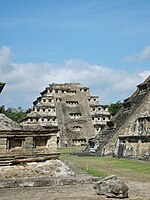
|
Papantla, Veracruz 20°26′47″N 97°22′38″W / 20.44639°N 97.37722°W |
Cultural: (i)(ii)(iv) |
176.5 (436) | 1992 | Located in the state of Veracruz, El Tajin was at its height from the early 9th to the early 13th century. It became the most important centre in north-east Mesoamerica after the fall of the Teotihuacan Empire. Its cultural influence extended all along the Gulf and penetrated into the Maya region and the high plateaux of central Mexico. Its architecture, which is unique in Mesoamerica, is characterized by elaborate carved reliefs on the columns and frieze. The 'Pyramid of the Niches', a masterpiece of ancient Mexican and American architecture, reveals the astronomical and symbolic significance of the buildings. El Tajin has survived as an outstanding example of the grandeur and importance of the pre-Hispanic cultures of Mexico.[17] |
| Rock Paintings of the Sierra de San Francisco | 
|
Baja California Sur 27°39′20″N 112°54′58″W / 27.65556°N 112.91611°W |
Cultural: (i)(iii) |
182,600 (451,000) | 1993 | From c. 100 B.C. to A.D. 1300, the Sierra de San Francisco (in the El Vizcaino reserve, in Baja California) was home to a people who have now disappeared but who left one of the most outstanding collections of rock paintings in the world. They are remarkably well-preserved because of the dry climate and the inaccessibility of the site. Showing human figures and many animal species and illustrating the relationship between humans and their environment, the paintings reveal a highly sophisticated culture. Their composition and size, as well as the precision of the outlines and the variety of colours, but especially the number of sites, make this an impressive testimony to a unique artistic tradition.[18] |
| Whale Sanctuary of El Vizcaino | 
|
Baja California Sur 27°47′32″N 114°13′40″W / 27.79222°N 114.22778°W |
Natural: (x) |
369,631 (913,380) | 1993 | Located in the central part of the peninsula of Baja California, the sanctuary contains some exceptionally interesting ecosystems. The coastal lagoons of Ojo de Liebre and San Ignacio are important reproduction and wintering sites for the grey whale, harbour seal, California sea lion, northern elephant-seal and blue whale. The lagoons are also home to four species of the endangered marine turtle.[19] |
| Historic Centre of Zacatecas | 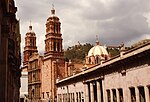
|
Zacatecas 22°46′0″N 102°33′20″W / 22.76667°N 102.55556°W |
Cultural: (ii)(iv) |
207.72 (513.3) | 1993 | Founded in 1546 after the discovery of a rich silver lode, Zacatecas reached the height of its prosperity in the 16th and 17th centuries. Built on the steep slopes of a narrow valley, the town has breathtaking views and there are many old buildings, both religious and civil. The cathedral, built between 1730 and 1760, dominates the centre of the town. It is notable for its harmonious design and the Baroque profusion of its façades, where European and indigenous decorative elements are found side by side.[20] |
| Earliest 16th-Century Monasteries on the Slopes of Popocatepetl | 
|
Morelos and Puebla 18°56′5″N 98°53′52″W / 18.93472°N 98.89778°W |
Cultural: (ii)(iv) |
— | 1994 | These 14 monasteries stand on the slopes of Popocatepetl, to the south-east of Mexico City. They are in an excellent state of conservation and are good examples of the architectural style adopted by the first missionaries – Franciscans, Dominicans and Augustinians – who converted the indigenous populations to Christianity in the early 16th century. They also represent an example of a new architectural concept in which open spaces are of renewed importance. The influence of this style is felt throughout the Mexican territory and even beyond its borders.[21] |
| Historic Monuments Zone of Querétaro | 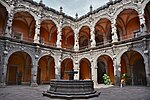
|
Querétaro 20°35′0″N 100°22′0″W / 20.58333°N 100.36667°W |
Cultural: (ii)(iv) |
— | 1996 | The old colonial town of Querétaro is unusual in having retained the geometric street plan of the Spanish conquerors side by side with the twisting alleys of the Indian quarters. The Otomi, the Tarasco, the Chichimeca and the Spanish lived together peacefully in the town, which is notable for the many ornate civil and religious Baroque monuments from its golden age in the 17th and 18th centuries.[22] |
| Pre-Hispanic Town of Uxmal | 
|
Yucatán 20°21′42″N 89°46′13″W / 20.36167°N 89.77028°W |
Cultural: (i)(ii)(iii) |
— | 1996 | The Mayan town of Uxmal, in Yucatán, was founded c. A.D. 700 and had some 25,000 inhabitants. The layout of the buildings, which date from between 700 and 1000, reveals a knowledge of astronomy. The Pyramid of the Soothsayer, as the Spaniards called it, dominates the ceremonial centre, which has well-designed buildings decorated with a profusion of symbolic motifs and sculptures depicting Chaac, the god of rain. The ceremonial sites of Uxmal, Kabah, Labna and Sayil are considered the high points of Mayan art and architecture.[23] |
| Hospicio Cabañas, Guadalajara | 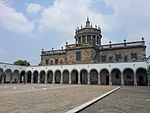
|
Jalisco 20°40′26″N 103°20′23″W / 20.67389°N 103.33972°W |
Cultural: (i)(ii)(iii)(iv) |
— | 1997 | The Hospicio Cabañas was built at the beginning of the 19th century to provide care and shelter for the disadvantaged – orphans, old people, the handicapped and chronic invalids. This remarkable complex, which incorporates several unusual features designed specifically to meet the needs of its occupants, was unique for its time. It is also notable for the harmonious relationship between the open and built spaces, the simplicity of its design, and its size. In the early 20th century, the chapel was decorated with a superb series of murals, now considered some of the masterpieces of Mexican art. They are the work of José Clemente Orozco, one of the greatest Mexican muralists of the period.[24] |
| Historic Monuments Zone of Tlacotalpan | 
|
Veracruz 18°36′30″N 95°39′30″W / 18.60833°N 95.65833°W |
Cultural: (ii)(iv) |
75 (190) | 1998 | Tlacotalpan, a Spanish colonial river port on the Gulf coast of Mexico, was founded in the mid-16th century. It has preserved its original urban fabric to a remarkable degree, with wide streets, colonnaded houses in a profusion of styles and colours, and many mature trees in the public open spaces and private gardens.[25] |
| Archaeological Zone of Paquimé, Casas Grandes | 
|
Chihuahua 30°22′33″N 107°57′20″W / 30.37583°N 107.95556°W |
Cultural: (iii)(iv) |
146.72 (362.6) | 1998 | Paquimé, Casas Grandes, which reached its apogee in the 14th and 15th centuries, played a key role in trade and cultural contacts between the Pueblo culture of the south-western United States and northern Mexico and the more advanced civilizations of Mesoamerica. The extensive remains, only part of which have been excavated, are clear evidence of the vitality of a culture which was perfectly adapted to its physical and economic environment, but which suddenly vanished at the time of the Spanish Conquest.[26] |
| Historic Fortified Town of Campeche | 
|
Campeche 19°50′47″N 90°32′14″W / 19.84639°N 90.53722°W |
Cultural: (ii)(iv) |
181 (450) | 1999 | Campeche is a typical example of a harbour town from the Spanish colonial period in the New World. The historic centre has kept its outer walls and system of fortifications, designed to defend this Caribbean port against attacks from the sea.[27] |
| Archaeological Monuments Zone of Xochicalco | 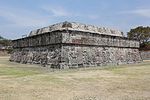
|
Morelos 18°48′37″N 99°16′30″W / 18.81028°N 99.27500°W |
Cultural: (iii)(iv) |
707.65 (1,748.6) | 1999 | Xochicalco is an exceptionally well-preserved example of a fortified political, religious and commercial centre from the troubled period of 650–900 that followed the break-up of the great Mesoamerican states such as Teotihuacan, Monte Albán, Palenque and Tikal.[28] |
| Franciscan Missions in the Sierra Gorda of Querétaro | 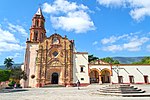
|
Querétaro de Arteaga 21°12′16″N 99°27′51″W / 21.20444°N 99.46417°W |
Cultural: (ii)(iii) |
103.7 (256) | 2003 | The five Franciscan missions of Sierra Gorda were built during the last phase of the conversion to Christianity of the interior of Mexico in the mid-18th century and became an important reference for the continuation of the evangelization of California, Arizona and Texas. The richly decorated church façades are of special interest as they represent an example of the joint creative efforts of the missionaries and the Indios. The rural settlements that grew around the missions have retained their vernacular character.[29] |
| Luis Barragán House and Studio | 
|
Mexico City 19°25′6″N 99°11′54″W / 19.41833°N 99.19833°W |
Cultural: (i)(ii) |
0.1161 (0.287) | 2004 | Built in 1948, the House and Studio of architect Luis Barragán in the suburbs of Mexico City represents an outstanding example of the architect’s creative work in the post-Second World War period. The concrete building, totalling 1,161 m2, consists of a ground floor and two upper storeys, as well as a small private garden. Barragán’s work integrated modern and traditional artistic and vernacular currents and elements into a new synthesis, which has been greatly influential, especially in the contemporary design of gardens, plazas and landscapes.[30] |
| Islands and Protected Areas of the Gulf of California† | 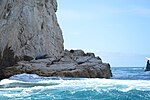
|
Baja California, Baja California Sur, Sonora, Sinaloa and Nayarit 27°37′36″N 112°32′45″W / 27.62667°N 112.54583°W |
Natural: (vii)(ix)(x) |
688,558 (1,701,460) | 2005 | [31][32] |
| Agave Landscape and Ancient Industrial Facilities of Tequila | 
|
Jalisco 20°51′47″N 103°46′43″W / 20.86306°N 103.77861°W |
Cultural: (ii)(iv)(v)(vi) |
35,018.852 (86,533.47) | 2006 | The 34,658 ha site, between the foothills of the Tequila Volcano and the deep valley of the Rio Grande River, is part of an expansive landscape of blue agave, shaped by the culture of the plant used since the 16th century to produce tequila spirit and for at least 2,000 years to make fermented drinks and cloth. Within the landscape are working distilleries reflecting the growth in the international consumption of tequila in the 19th and 20th centuries. Today, the agave culture is seen as part of national identity. The area encloses a living, working landscape of blue agave fields and the urban settlements of Tequila, Arenal, and Amatitan with large distilleries where the agave ‘pineapple' is fermented and distilled. The property is also a testimony to the Teuchitlan cultures which shaped the Tequila area from AD 200-900, notably through the creation of terraces for agriculture, housing, temples, ceremonial mounds and ball courts.[33] |
| Central University City Campus of the Universidad Nacional Autónoma de México (UNAM) | 
|
Mexico City 19°19′56″N 99°11′17″W / 19.33222°N 99.18806°W |
Cultural: (i)(ii)(iv) |
176.5 (436) | 2007 | The ensemble of buildings, sports facilities and open spaces of the Central University City Campus of the Universidad Nacional Autónoma de México (UNAM), was built from 1949 to 1952 by more than 60 architects, engineers and artists who were involved in the project. As a result, the campus constitutes a unique example of 20th-century modernism integrating urbanism, architecture, engineering, landscape design and fine arts with references to local traditions, especially to Mexico’s pre-Hispanic past. The ensemble embodies social and cultural values of universal significance and is one of the most significant icons of modernity in Latin America.[34] |
| Monarch Butterfly Biosphere Reserve |  
|
Michoacán and State of Mexico 19°36′23″N 100°14′30″W / 19.60639°N 100.24167°W |
Natural: (vii) |
13,551.552 (33,486.61) | 2008 | The 56,259 ha biosphere lies within rugged forested mountains between the states of Michoacán and Mexico. Every autumn, millions, perhaps a billion, butterflies from wide areas of North America return to the site and cluster on small areas of the forest reserve, colouring its trees orange and literally bending their branches under their collective weight. In the spring, these butterflies begin an 8 month migration that takes them all the way to Eastern Canada and back, during which time four successive generations are born and die. How they find their way back to their overwintering site remains a mystery.[35] |
| Protective town of San Miguel de Allende and the Sanctuary of Jesús Nazareno de Atotonilco | 
|
Guanajuato 20°54′52″N 100°44′47″W / 20.91444°N 100.74639°W |
Cultural: (ii)(iv) |
46.95 (116.0) | 2008 | The fortified town, first established in the 16th century to protect the Royal Route inland, reached its apogee in the 18th century when many of its outstanding religious and civic buildings were built in the style of the Mexican Baroque. Some of these buildings are masterpieces of the style that evolved in the transition from Baroque to neoclassical. Situated 14 km from the town, the Jesuit sanctuary, also dating from the 18th century, is one of the finest examples of Baroque art and architecture in the New Spain. It consists of a large church, and several smaller chapels, all decorated with oil paintings by Rodriguez Juárez and mural paintings by Miguel Antonio Martínez de Pocasangre. Because of its location, San Miguel de Allende acted as a melting pot where Spaniards, Creoles and Amerindians exchanged cultural influences while the Sanctuary of Jesús Nazareno de Atotonilco constitutes an exceptional example of the exchange between European and Latin American cultures. Its architecture and interior decoration testify to the influence of Saint Ignacio de Loyola’s doctrine.[36] |
| Camino Real de Tierra Adentro |   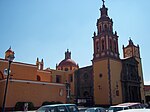    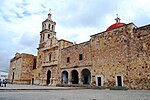    |
Various states 22°36′29″N 102°22′45″W / 22.60806°N 102.37917°W |
Cultural: (ii)(iv) |
3,101.91 (7,665.0) | 2010 | Camino Real de Tierra Adentro was the Royal Inland Road, also known as the Silver Route. The inscribed property consists of 55 sites and five existing World Heritage sites lying along a 1400 km section of this 2600 km route, that extends north from Mexico City to Texas and New Mexico, United States of America. The route was actively used as a trade route for 300 years, from the mid-16th to the 19th centuries, mainly for transporting silver extracted from the mines of Zacatecas, Guanajuato and San Luis Potosí, and mercury imported from Europe. Although it is a route that was motivated and consolidated by the mining industry, it also fostered the creation of social, cultural and religious links in particular between Spanish and Amerindian cultures.[37] |
| Prehistoric Caves of Yagul and Mitla in the Central Valley of Oaxaca | 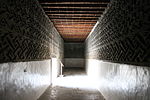 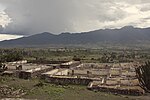 |
Oaxaca 16°57′3″N 96°25′16″W / 16.95083°N 96.42111°W |
Cultural: (iii) |
1,515.17 (3,744.1) | 2010 | This property lies on the northern slopes of the Tlacolula valley in subtropical central Oaxaca and consists of two pre-Hispanic archaeological complexes and a series of pre-historic caves and rock shelters. Some of these shelters provide archaeological and rock-art evidence for the progress of nomadic hunter-gathers to incipient farmers. Ten thousand-year-old Cucurbitaceae seeds in one cave, Guilá Naquitz, are considered to be the earliest known evidence of domesticated plants in the continent, while corn cob fragments from the same cave are said to be the earliest documented evidence for the domestication of maize. The cultural landscape of the Prehistoric Caves of Yagul and Mitla demonstrates the link between man and nature that gave origin to the domestication of plants in North America, thus allowing the rise of Mesoamerican civilizations.[38] |
| El Pinacate and Gran Desierto de Altar Biosphere Reserve | 
|
Sonora 32°0′0″N 113°55′0″W / 32.00000°N 113.91667°W |
Natural: (vii)(viii)(x) |
714,566 (1,765,730) | 2013 | The 714,566-hectare (2,758.95 sq mi) site comprises two distinct parts: the dormant volcanic Pinacate Shield of black and red lava flows and desert pavements to the east, and, in the west, the Gran Altar Desert with its ever changing and varied sand dunes that can reach a height of 200 metres. This landscape of dramatic contrast notably features linear, star and dome dunes as well as several arid granite massifs, some as high as 650 metres. The dunes emerge like islands from the sea of sand and harbour distinct and highly diverse plant and wildlife communities, including endemic freshwater fish species and the endemic Sonoran Pronghorn, which is only to be found in northwestern Sonora and in southwestern Arizona (USA). Ten enormous, deep and almost perfectly circular craters, believed to have been formed by a combination of eruptions and collapses, also contribute to the dramatic beauty of the site whose exceptional combination of features are of great scientific interest.[39] |
| Ancient Maya City and Protected Tropical Forests of Calakmul, Campeche | 
|
Campeche 18°3′11″N 89°44′14″W / 18.05306°N 89.73722°W |
Mixed: (i)(ii)(iii)(iv)(ix)(x) |
331,397 (818,900) | 2014 | The site is located in the central/southern portion of the Yucatán Peninsula, in southern Mexico and includes the remains of the important Maya city Calakmul, set deep in the tropical forest of the Tierras Bajas. The city played a key role in the history of this region for more than twelve centuries and is characterized by well-preserved structures providing a vivid picture of life in an ancient Maya capital. The property also falls within the Mesoamerica biodiversity hotspot, the third largest in the world, encompassing all subtropical and tropical ecosystems from central Mexico to the Panama Canal.[40] |
| Aqueduct of Padre Tembleque Hydraulic System | 
|
State of Mexico and Hidalgo 19°50′7″N 98°39′45″W / 19.83528°N 98.66250°W |
Cultural: (i)(ii)(iv) |
6,540 (16,200) | 2015 | This 16th century aqueduct is located between the states of Mexico and Hidalgo, on the Central Mexican Plateau. This heritage canal system encompasses a water catchment area, springs, canals, distribution tanks and arcaded aqueduct bridges. The site incorporates the highest single-level arcade ever built in an aqueduct. Initiated by the Franciscan friar, Padre Tembleque, and built with support from the local indigenous communities, this hydraulic system is an example of the exchange of influences between the European tradition of Roman hydraulics and traditional Mesoamerican construction techniques, including the use of adobe.[41] |
| Revillagigedo Archipelago | 
|
Colima 18°47′17″N 110°58′31″W / 18.78806°N 110.97528°W |
Natural: (vii)(ix)(x) |
636,685.375 (1,573,283.82) | 2016 | Located in the eastern Pacific Ocean, this archipelago is made up of four remote islands and their surrounding waters: San Benedicto, Socorro, Roca Partida and Clarión. This archipelago is part of a submerged mountain range, with the four islands representing the peaks of volcanoes emerging above sea level. The islands provide critical habitat for a range of wildlife and are of particular importance for seabirds. The surrounding waters have a remarkable abundance of large pelagic species, such as manta rays, whales, dolphins and sharks.[42] |
| Tehuacán-Cuicatlán Valley: originary habitat of Mesoamerica | 
|
Puebla and Oaxaca 17°59′24″N 97°11′14″W / 17.99000°N 97.18722°W |
Mixed: (iv)(x) |
145,255.2 (358,933) | 2018 | Tehuacán-Cuicatlán Valley, part of the Mesoamerican region, is the arid or semi-arid zone with the richest biodiversity in all of North America. Consisting of three components, Zapotitlán-Cuicatlán, San Juan Raya and Purrón, it is one of the main centres of diversification for the cacti family, which is critically endangered worldwide. The valley harbours the densest forests of columnar cacti in the world, shaping a unique landscape that also includes agaves, yuccas and oaks. Archaeological remains demonstrate technological developments and the early domestication of crops. The valley presents an exceptional water management system of canals, wells, aqueducts and dams, the oldest in the continent, which has allowed for the emergence of agricultural settlements.[43] |
Tentative list[edit]
In addition to sites inscribed on the World Heritage list, member states can maintain a list of tentative sites that they may consider for nomination. Nominations for the World Heritage list are only accepted if the site was previously listed on the tentative list.[44] As of 2023, Mexico maintains twenty-three properties on its tentative list:[4]
Pending transboundary nominations[edit]

In 2014, the idea to nominate the Manila-Acapulco Galleon Trade Route was initiated by the Mexican ambassador to UNESCO with the Filipino ambassador to UNESCO.
An Experts' Roundtable Meeting was held at the University of Santo Tomas (UST) on April 23, 2015 as part of the preparation of the Philippines for the possible transnational nomination of the Manila-Acapulco Galleon Trade Route to the World Heritage List. The nomination will be made jointly with Mexico.
The following are the experts and the topics they discussed during the roundtable meeting: Dr. Celestina Boncan on the Tornaviaje; Dr. Mary Jane A. Bolunia on Shipyards in the Bicol Region; Mr. Sheldon Clyde Jago-on, Bobby Orillaneda, and Ligaya Lacsina on Underwater Archaeology; Dr. Leovino Garcia on Maps and Cartography; Fr. Rene Javellana, S.J. on Fortifications in the Philippines; Felice Sta. Maria on Food; Dr. Fernando Zialcita on Textile; and Regalado Trota Jose on Historical Dimension. The papers presented and discussed during the roundtable meeting will be synthesized into a working document to establish the route's Outstanding Universal Value.[68]
The Mexican side reiterated that they will also follow suit with the preparations for the route's nomination.
Spain has also backed the nomination of the route in the World Heritage List and has also suggested the archives related to the route under the possession of the Philippines, Mexico, and Spain to be nominated as part of another UNESCO list, the Memory of the World Register.[69]
In 2017, the Philippines established the Manila-Acapulco Galleon Museum in Metro Manila.[70]
| Type (criteria) | Site | Location | Description | Image | Ref |
|---|---|---|---|---|---|
| Mixed | The Historic Manila‑Acapulco Galleon Trade Route | Philippines and Mexico |  |
[68] |
References[edit]
- ^ "The World Heritage Convention". UNESCO. Retrieved 21 September 2010.
- ^ "Mexico". UNESCO. Retrieved 2 July 2018.
- ^ "Report of the 11th Session of the Committee". UNESCO. Retrieved 16 July 2017.
- ^ a b "Tentative List – Mexico". UNESCO. Retrieved 16 July 2017.
- ^ "UNESCO World Heritage Sites in Mexico". Mexican Routes [mexicanroutes.com].
- ^ "World Heritage List". UNESCO. Retrieved 28 May 2010.
- ^ "The Criteria for Selection". UNESCO. Retrieved 10 September 2011.
- ^ "Historic Centre of Mexico City and Xochimilco". UNESCO. Retrieved 16 July 2017.
 Text was copied from this source, which is available under a Creative Commons Attribution 3.0 IGO (CC BY 3.0 IGO) license.
Text was copied from this source, which is available under a Creative Commons Attribution 3.0 IGO (CC BY 3.0 IGO) license.
- ^ "Historic Centre of Oaxaca and Archaeological Site of Monte Albán". UNESCO. Retrieved 16 July 2017.
 Text was copied from this source, which is available under a Creative Commons Attribution-ShareAlike 3.0 IGO license.
Text was copied from this source, which is available under a Creative Commons Attribution-ShareAlike 3.0 IGO license.
- ^ "Historic Centre of Puebla". UNESCO. Retrieved 16 July 2017.
 Text was copied from this source, which is available under a Creative Commons Attribution 3.0 IGO (CC BY 3.0 IGO) license.
Text was copied from this source, which is available under a Creative Commons Attribution 3.0 IGO (CC BY 3.0 IGO) license.
- ^ "Pre-Hispanic City and National Park of Palenque". UNESCO. Retrieved 16 July 2017.
 Text was copied from this source, which is available under a Creative Commons Attribution-ShareAlike 3.0 IGO license.
Text was copied from this source, which is available under a Creative Commons Attribution-ShareAlike 3.0 IGO license.
- ^ "Pre-Hispanic City of Teotihuacan". UNESCO. Retrieved 16 July 2017.
 Text was copied from this source, which is available under a Creative Commons Attribution 3.0 IGO (CC BY 3.0 IGO) license.
Text was copied from this source, which is available under a Creative Commons Attribution 3.0 IGO (CC BY 3.0 IGO) license.
- ^ "Sian Ka'an". UNESCO. Retrieved 16 July 2017.
 Text was copied from this source, which is available under a Creative Commons Attribution-ShareAlike 3.0 IGO license.
Text was copied from this source, which is available under a Creative Commons Attribution-ShareAlike 3.0 IGO license.
- ^ "Historic Town of Guanajuato and Adjacent Mines". UNESCO. Retrieved 16 July 2017.
 Text was copied from this source, which is available under a Creative Commons Attribution 3.0 IGO (CC BY 3.0 IGO) license.
Text was copied from this source, which is available under a Creative Commons Attribution 3.0 IGO (CC BY 3.0 IGO) license.
- ^ "Pre-Hispanic City of Chichen-Itza". UNESCO. Retrieved 16 July 2017.
 Text was copied from this source, which is available under a Creative Commons Attribution 3.0 IGO (CC BY 3.0 IGO) license.
Text was copied from this source, which is available under a Creative Commons Attribution 3.0 IGO (CC BY 3.0 IGO) license.
- ^ "Historic Centre of Morelia". UNESCO. Retrieved 16 July 2017.
 Text was copied from this source, which is available under a Creative Commons Attribution 3.0 IGO (CC BY 3.0 IGO) license.
Text was copied from this source, which is available under a Creative Commons Attribution 3.0 IGO (CC BY 3.0 IGO) license.
- ^ "El Tajin, Pre-Hispanic City". UNESCO. Retrieved 16 July 2017.
 Text was copied from this source, which is available under a Creative Commons Attribution-ShareAlike 3.0 IGO license.
Text was copied from this source, which is available under a Creative Commons Attribution-ShareAlike 3.0 IGO license.
- ^ "Rock Paintings of the Sierra de San Francisco". UNESCO. Retrieved 16 July 2017.
 Text was copied from this source, which is available under a Creative Commons Attribution-ShareAlike 3.0 IGO license.
Text was copied from this source, which is available under a Creative Commons Attribution-ShareAlike 3.0 IGO license.
- ^ "Whale Sanctuary of El Vizcaino". UNESCO. Retrieved 16 July 2017.
 Text was copied from this source, which is available under a Creative Commons Attribution-ShareAlike 3.0 IGO license.
Text was copied from this source, which is available under a Creative Commons Attribution-ShareAlike 3.0 IGO license.
- ^ "Historic Centre of Zacatecas". UNESCO. Retrieved 16 July 2017.
 Text was copied from this source, which is available under a Creative Commons Attribution 3.0 IGO (CC BY 3.0 IGO) license.
Text was copied from this source, which is available under a Creative Commons Attribution 3.0 IGO (CC BY 3.0 IGO) license.
- ^ "Earliest 16th-Century Monasteries on the Slopes of Popocatepetl". UNESCO. Retrieved 16 July 2017.
 Text was copied from this source, which is available under a Creative Commons Attribution 3.0 IGO (CC BY 3.0 IGO) license.
Text was copied from this source, which is available under a Creative Commons Attribution 3.0 IGO (CC BY 3.0 IGO) license.
- ^ "Historic Monuments Zone of Querétaro". UNESCO. Retrieved 16 July 2017.
 Text was copied from this source, which is available under a Creative Commons Attribution 3.0 IGO (CC BY 3.0 IGO) license.
Text was copied from this source, which is available under a Creative Commons Attribution 3.0 IGO (CC BY 3.0 IGO) license.
- ^ "Pre-Hispanic Town of Uxmal". UNESCO. Retrieved 16 July 2017.
 Text was copied from this source, which is available under a Creative Commons Attribution-ShareAlike 3.0 IGO license.
Text was copied from this source, which is available under a Creative Commons Attribution-ShareAlike 3.0 IGO license.
- ^ "Hospicio Cabañas, Guadalajara". UNESCO. Retrieved 16 July 2017.
 Text was copied from this source, which is available under a Creative Commons Attribution 3.0 IGO (CC BY 3.0 IGO) license.
Text was copied from this source, which is available under a Creative Commons Attribution 3.0 IGO (CC BY 3.0 IGO) license.
- ^ "Historic Monuments Zone of Tlacotalpan". UNESCO. Retrieved 16 July 2017.
 Text was copied from this source, which is available under a Creative Commons Attribution-ShareAlike 3.0 IGO license.
Text was copied from this source, which is available under a Creative Commons Attribution-ShareAlike 3.0 IGO license.
- ^ "Archaeological Zone of Paquimé, Casas Grandes". UNESCO. Retrieved 16 July 2017.
 Text was copied from this source, which is available under a Creative Commons Attribution 3.0 IGO (CC BY 3.0 IGO) license.
Text was copied from this source, which is available under a Creative Commons Attribution 3.0 IGO (CC BY 3.0 IGO) license.
- ^ "Historic Fortified Town of Campeche". UNESCO. Retrieved 16 July 2017.
 Text was copied from this source, which is available under a Creative Commons Attribution-ShareAlike 3.0 IGO license.
Text was copied from this source, which is available under a Creative Commons Attribution-ShareAlike 3.0 IGO license.
- ^ "Archaeological Monuments Zone of Xochicalco". UNESCO. Retrieved 16 July 2017.
 Text was copied from this source, which is available under a Creative Commons Attribution 3.0 IGO (CC BY 3.0 IGO) license.
Text was copied from this source, which is available under a Creative Commons Attribution 3.0 IGO (CC BY 3.0 IGO) license.
- ^ "Franciscan Missions in the Sierra Gorda of Querétaro". UNESCO. Retrieved 16 July 2017.
 Text was copied from this source, which is available under a Creative Commons Attribution 3.0 IGO (CC BY 3.0 IGO) license.
Text was copied from this source, which is available under a Creative Commons Attribution 3.0 IGO (CC BY 3.0 IGO) license.
- ^ "Luis Barragán House and Studio". UNESCO. Retrieved 16 July 2017.
 Text was copied from this source, which is available under a Creative Commons Attribution-ShareAlike 3.0 IGO license.
Text was copied from this source, which is available under a Creative Commons Attribution-ShareAlike 3.0 IGO license.
- ^ "Islands and Protected Areas of the Gulf of California". UNESCO. Retrieved 16 July 2017.
- ^ "The Islands and Protected Areas of the Gulf of California (Mexico) inscribed on the List of World Heritage in Danger". UNESCO. Retrieved 8 July 2019.
- ^ "Agave Landscape and Ancient Industrial Facilities of Tequila". UNESCO. Retrieved 16 July 2017.
 Text was copied from this source, which is available under a Creative Commons Attribution 3.0 IGO (CC BY 3.0 IGO) license.
Text was copied from this source, which is available under a Creative Commons Attribution 3.0 IGO (CC BY 3.0 IGO) license.
- ^ "Central University City Campus of the Universidad Nacional Autónoma de México (UNAM)". UNESCO. Retrieved 16 July 2017.
 Text was copied from this source, which is available under a Creative Commons Attribution 3.0 IGO (CC BY 3.0 IGO) license.
Text was copied from this source, which is available under a Creative Commons Attribution 3.0 IGO (CC BY 3.0 IGO) license.
- ^ "Monarch Butterfly Biosphere Reserve". UNESCO. Retrieved 16 July 2017.
 Text was copied from this source, which is available under a Creative Commons Attribution 3.0 IGO (CC BY 3.0 IGO) license.
Text was copied from this source, which is available under a Creative Commons Attribution 3.0 IGO (CC BY 3.0 IGO) license.
- ^ "Protective town of San Miguel and the Sanctuary of Jesús Nazareno de Atotonilco". UNESCO. Retrieved 16 July 2017.
 Text was copied from this source, which is available under a Creative Commons Attribution 3.0 IGO (CC BY 3.0 IGO) license.
Text was copied from this source, which is available under a Creative Commons Attribution 3.0 IGO (CC BY 3.0 IGO) license.
- ^ "Camino Real de Tierra Adentro". UNESCO. Retrieved 16 July 2017.
 Text was copied from this source, which is available under a Creative Commons Attribution-ShareAlike 3.0 IGO license.
Text was copied from this source, which is available under a Creative Commons Attribution-ShareAlike 3.0 IGO license.
- ^ "Prehistoric Caves of Yagul and Mitla in the Central Valley of Oaxaca". UNESCO. Retrieved 16 July 2017.
 Text was copied from this source, which is available under a Creative Commons Attribution-ShareAlike 3.0 IGO license.
Text was copied from this source, which is available under a Creative Commons Attribution-ShareAlike 3.0 IGO license.
- ^ "El Pinacate and Gran Desierto de Altar Biosphere Reserve". UNESCO. Retrieved 16 July 2017.
 Text was copied from this source, which is available under a Creative Commons Attribution 3.0 IGO (CC BY 3.0 IGO) license.
Text was copied from this source, which is available under a Creative Commons Attribution 3.0 IGO (CC BY 3.0 IGO) license.
- ^ "Ancient Maya City and Protected Tropical Forests of Calakmul, Campeche". UNESCO. Retrieved 16 July 2017.
 Text was copied from this source, which is available under a Creative Commons Attribution-ShareAlike 3.0 IGO license.
Text was copied from this source, which is available under a Creative Commons Attribution-ShareAlike 3.0 IGO license.
- ^ "Aqueduct of Padre Tembleque Hydraulic System". UNESCO. Retrieved 16 July 2017.
 Text was copied from this source, which is available under a Creative Commons Attribution 3.0 IGO (CC BY 3.0 IGO) license.
Text was copied from this source, which is available under a Creative Commons Attribution 3.0 IGO (CC BY 3.0 IGO) license.
- ^ "Archipiélago de Revillagigedo". UNESCO. Retrieved 16 July 2017.
 Text was copied from this source, which is available under a Creative Commons Attribution 3.0 IGO (CC BY 3.0 IGO) license.
Text was copied from this source, which is available under a Creative Commons Attribution 3.0 IGO (CC BY 3.0 IGO) license.
- ^ "Tehuacán-Cuicatlán Valley: originary habitat of Mesoamerica". UNESCO. Retrieved 2 July 2018.
 Text was copied from this source, which is available under a Creative Commons Attribution 3.0 IGO (CC BY 3.0 IGO) license.
Text was copied from this source, which is available under a Creative Commons Attribution 3.0 IGO (CC BY 3.0 IGO) license.
- ^ "Tentative Lists". UNESCO. Retrieved 7 October 2010.
- ^ "Chapultepec Woods, Hill and Castle". UNESCO World Heritage Centre. Retrieved 2021-04-13.
- ^ "Church of Santa Prisca and its Surroundings". UNESCO World Heritage Centre. Retrieved 2021-04-13.
- ^ "Diego Rivera and Frida Kahlo's Home-Study Museum". UNESCO World Heritage Centre. Retrieved 2021-04-13.
- ^ "Great City of Chicomostoc-La Quemada". UNESCO World Heritage Centre. Retrieved 2021-04-13.
- ^ "Historic Town of Alamos". UNESCO World Heritage Centre. Retrieved 2021-04-13.
- ^ "Historic Town of San Sebastián del Oeste". UNESCO World Heritage Centre. Retrieved 2021-04-13.
- ^ "Pre-Hispanic City of Cantona". UNESCO World Heritage Centre. Retrieved 2021-04-13.
- ^ "Banco Chinchorro Biosphere Reserve". UNESCO World Heritage Centre. Retrieved 2021-04-13.
- ^ "Flora and Fauna Protection Area of Cuatro Ciénegas". UNESCO World Heritage Centre. Retrieved 2021-04-13.
- ^ "Historical Town The Royal of the Eleven Thousand Virgins of Cosala in Sinaloa". UNESCO World Heritage Centre. Retrieved 2021-04-13.
- ^ "Huichol Route through the sacred sites to Huiricuta (Tatehuari Huajuye)". UNESCO World Heritage Centre. Retrieved 2021-04-13.
- ^ "Lacan-Tún – Usumacinta Region". UNESCO World Heritage Centre. Retrieved 2021-04-13.
- ^ "Tecoaque". UNESCO World Heritage Centre. Retrieved 2021-04-13.
- ^ "Valle de los Cirios". UNESCO World Heritage Centre. Retrieved 2021-04-13.
- ^ "Cuetzalan and its Historical, Cultural and Natural Surrounding". UNESCO World Heritage Centre. Retrieved 2021-04-13.
- ^ "Historical city of Izamal (Izamal, Mayan continuity in an Historical City)". UNESCO World Heritage Centre. Retrieved 2021-04-13.
- ^ "Los Petenes-Ría Celestún". UNESCO World Heritage Centre. Retrieved 2021-04-13.
- ^ "Las Pozas, Xilitla". UNESCO World Heritage Centre. Retrieved 2021-04-13.
- ^ "El Arco del Tiempo del Río La Venta". UNESCO World Heritage Centre. Retrieved 2021-04-13.
- ^ "Las Labradas, Sinaloa archaeological site". UNESCO World Heritage Centre. Retrieved 2021-04-13.
- ^ "Ring of cenotes of Chicxulub Crater, Yucatan". UNESCO World Heritage Centre. Retrieved 2021-04-13.
- ^ "San Juan de Ulua, Site of Memory and Historical Resistances". UNESCO World Heritage Centre. Retrieved 2021-04-13.
- ^ "Patzcuaro, Site of Humanistic Memory and Cultural Confluence". UNESCO World Heritage Centre. Retrieved 2021-04-13.
- ^ a b
 One or more of the preceding sentences incorporates text from this source, which is in the public domain: "PH, Mexico push to nominate Manila-Acapulco Galleon Trade Route to World Heritage List". Official Gazette of the Republic of the Philippines. 28 April 2015. Retrieved 14 December 2017.
One or more of the preceding sentences incorporates text from this source, which is in the public domain: "PH, Mexico push to nominate Manila-Acapulco Galleon Trade Route to World Heritage List". Official Gazette of the Republic of the Philippines. 28 April 2015. Retrieved 14 December 2017.
- ^ "Archived copy". Archived from the original on 2017-12-14. Retrieved 2017-12-14.
{{cite web}}: CS1 maint: archived copy as title (link) - ^ "Manila-Acapulco Galleon Museum rises in SM MOA - BusinessMirror". businessmirror.com.ph.



